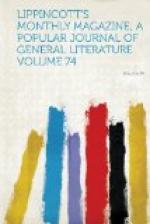On the river-front is a long bed of oysters, growing up to high-water mark, the upper ones poor, called “raccoon oysters” by the natives, but the lower ones, which are mostly covered with water, large, fat and delicious. We gathered about a bushel of these, built a fire of dead mangrove wood, which is the best of fuel, and when we had a good bed of coals threw on the oysters. The heat, at the same time that it roasted them, obliged them to open their valves, so that it was both easy and pleasant to take them on the half shell. Besides these free gifts of Nature, we had with us from the hotel biscuits, cold meat and doughnuts. While we were eating, a handsome sailboat from the hotel came to the beach: it contained a party of ladies and gentlemen who were going for shells, which are numerous on the sea-beach, though not many of the finer sorts are found so far north. After a heavy storm the paper nautilus is sometimes found. Sea-beans of various kinds are numerous, and the search for them, and the polishing of them when found, seem to be the principal occupations of many Florida tourists. Were it not for the sharks, this would be a fine bathing-beach. Whether they are man-eaters or not, may be a question, but we preferred to give ourselves the benefit of the doubt.
On our return to Loud’s we found Doctor White very busy skinning his birds.
“What is this, doctor?—a jay? It looks rather different from our blue jay.”
“Yes: this is the Florida jay: it has no crest, you perceive. Here is another Southern bird, the fish-crow, smaller than ours, you see. Here I have a white heron and a wood-ibis. These will give me work for to-day.”
“What game did you see, doctor?” inquired Captain Herbert.
“I saw some quails in the palmetto scrub behind the house, and shot one to see if it differs from ours. It is the same bird, Ortyx Virginiana: they call it partridge in the South—rather smaller than ours at the North. In the swamp I found snipe, Scolopax Wilsonii: they call them here jacksnipe. Here is one of them: did you ever see a fatter bird?”
“I should like to go and look them up to-morrow morning,” said the captain. “How far away were they?”
“About half a mile only, north-west. You will find some small ponds, and near them the snipe were plenty: there were wood-ducks there also.”
“I will go with you, captain,” said I. “We will take Morris’s old pointer, Dash: he is steady and staunch.”
About four o’clock that afternoon the hunting-party returned, bringing in three deer, six wild turkeys, twenty-five ducks, ten gray squirrels, and three rabbits, besides a wild steer, killed by Halliday. They had also killed a wild-cat, and a small alligator about seven feet long. A good heap of game it made.
“What are you going to do with that alligator, Captain Morris?” asked the doctor.
“I thought I should like to take home his hide to put in my hall. He was going for one of my hounds when I shot him.”




